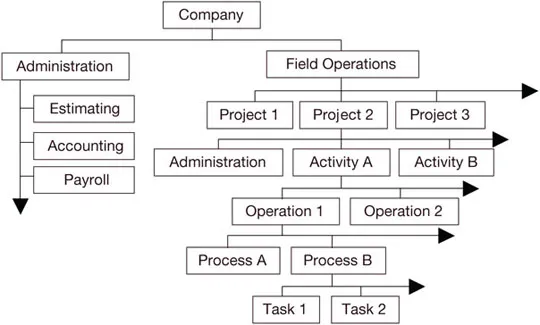![]()
MEASURING LABOR PRODUCTIVITY
Dr. Eddy M. Rojas, University of Washington
INTRODUCTION
The main goal of this chapter is to introduce practical and simple ways of measuring labor productivity in a contractor’s organization at different levels of detail. Higher productivity levels allow contractors to simultaneously increase profitability, improve competitiveness, and pay higher wages to workers, while completing activities sooner. Once a contractor is capable of measuring labor productivity, the effect of any factor or combination of factors can be assessed by comparing labor productivity values before and after the factor was in place. For example, the impact of a new managerial approach in productivity can be determined by measuring labor productivity before and after the new approach is implemented.
In order to measure labor productivity, this chapter defines seven different levels at which the measurements are to be implemented. The highest level is the construction company. The second level divides company operations into two distinctive segments: administration and field operations. The third level is the project. The fourth level is the activity. The fifth level is the construction operation. The sixth level in this stratification is the process. Finally, the seventh and most basic level is the task.
Table 1.1 Productivity, Duration, and Cost WHY DOES LABOR PRODUCTIVITY MATTER?
Labor productivity is considered one of the best indicators of production efficiency. Higher productivity levels usually translate into superior profitability. A sustainable improvement in labor productivity is also associated with economic progress as it generates noninflationary increases in salaries and wages.
The main goal of this chapter is to introduce practical and simple ways of measuring labor productivity in a contractor’s organization at different levels of detail. Once a contractor is capable of measuring labor productivity, the effect of any factor or combination of factors can be assessed by comparing labor productivity values before and after the factor was in place. For example, the impact of a new managerial approach in productivity can be determined by measuring labor productivity before and after the new approach is implemented. Furthermore, by calculating historical or typical productivity values, contractors can also identify projects under distress. Even though knowing that a project is under distress does not solve the situation, it allows contractors to start looking for the root causes of the problem and increases the chances of improving performance by implementing corrective actions early on.
The best way to understand the importance of labor productivity is through an example. Let’s look at the installation of two-hundred 24-inch-long, two-lamp, industrial-grade fluorescent fixtures by two crews with different productivity levels.
Table 1.1 depicts the specifics of our case, where Crew B is more productive than Crew A. This higher productivity could be recognized by the contractor by offering higher hourly wages to Crew B workers. In Table 1.1, Crew B workers are paid $38/hr versus $35/hr for Crew A workers. However, even with this wage differential, the contractor still achieves savings of more than 10% in total labor costs ($882). These savings could (1) go directly to the contractor’s bottom line to increase its profitability, (2) be fully transferred to the owner in an effort to improve the contractor’s competitiveness, or (3) be allocated at will to increase both profits and competitiveness. Table 1.1 also shows that Crew B would complete the job almost one full day earlier than Crew A. Therefore, the higher productivity of Crew B allows the contractor to simultaneously increase its profitability, improve its competitiveness, and pay higher wages to its workers while completing the activity sooner. A truly win-win situation for all parties involved.
A LABOR PRODUCTIVITY MODEL FOR CONSTRUCTION
The term “labor productivity” is commonly used in a variety of contexts with different meanings. Formally, productivity is defined as the output produced per unit of time. All U.S. government data about labor productivity published by the Bureau of Labor Statistics are expressed in this manner. Generally, the U.S. government uses inflation-adjusted dollars to express output and an hour as the unit of time. Therefore, it is common to find government data where labor productivity is stated as, for example, $50/hr.
In the construction industry, because of tradition and practical reasons, productivity is usually expressed as the amount of time required to produce a unit of output, where the unit of output varies according to the circumstance. Therefore, it is common to find industry data, such as the National Electrical Contractors Association (NECA) Manual of Labor Hours, where labor productivity is stated as, for example, 1.06 hrs/fixture or 16 hrs/100 linear feet.
These two definitions of labor productivity are equivalent, as they both express efficiency. A labor productivity of 1.06 hrs/fixture can be translated into $/hr if one knows the total cost (material, labor, equipment, and indirect costs) of the fixture to the owner. For example, if we assume that the total cost of each fixture to the owner is $212, we obtain a productivity of $200/hr by dividing $212 by 1.06.
The traditional definition of 1.06 hrs/fixture is more meaningful in the field and more useful during the cost estimating process than the definition of $200/hr. However, the more formal definition of $200/hr is needed if we want to combine field productivity data from different activities to calculate the overall labor productivity for an entire project. Otherwise, how can we combine productivity data such as 1.06 hrs/fixture with 16 hrs/100 linear feet? This illustrates that no universal definition of labor productivity can be applied to all circumstances.
There are other issues that also complicate the process of measuring labor productivity. For example, should we exclude or include breaks, walking time, and other so-called contributory activities when calculating the time required to install a fixture? Should we exclude or include lost time due to material unavailability, work stoppages, or interference from other trades? Should we focus on measuring productivity at the task level or at the process level when we can see how different activities interact with one another? Should we focus on measuring direct field productivity only or also the productivity of supervisors? Should we measure the productivity of administrative employees or only that of fieldworkers? Should we develop historical labor productivity data? And if so, how should we go about establishing baseline values? In order to answer these questions, it is necessary to define a labor productivity model for construction that can be used as a guideline to facilitate and simplify the process of measuring labor productivity.
Figure 1.1 Construction firm stratification diagram Figure 1.1 shows a construction firm stratification diagram. At the top of this stratification we have the construction company, which can be defined as an organization whose primary emphasis is to build a facility or some systems in a facility in order to satisfy customer’s expectations by providing quality at a reasonable cost while complying with industry and government standards regarding safety and environmental issues. At the company level, the main focus is on strategic business decisions such as market selection, definition of products and services, definition of growth and profitability targets, selection of personnel, and establishment of a succession plan among others.
The second level divides company operations into two distinctive segments: administration and field operations. Administration is commonly referred as home office overhead, and it is considered a necessary but non-value-added activity from the owner’s viewpoint.
The third level is the project. At the project level the main focus in on scope definition, identification of project requirements and construction activities, development of contractual arrangements, and planning and control of cost, time, and resources.
The fourth level is the activity. A construction activity is a physical segment of a project that consumes specific resources and requires a given amount of time for completion. Projects are broken down into activities to facilitate scheduling, as well as time and cost control. At the activity level the main focus is on early and late start and completion dates, activity float, percentage of completion, and resource consumption.
The fifth level is the construction operation. A construction operation is not a physical but a technological segment of a project. Therefore, a construction operation can span several activities. In other words, the same construction operation could be part of more than one activity. A construction operation is also cyclical or repetitive. At the operation level the main focus is on construction methods and technologies.
The sixth level in this stratification is the process. A process is a segment of a construction operation that uses the same resources. In simple operations, when only one process exists, process and operation become synonymous. The main focus at the process level is on technological sequencing and logical collection of tasks.
Finally, the seventh and most basic level is the task. A task is an elemental work assignment. The main focus at the task level is on intrinsic knowledge and skills of crew members.
The best way to understand this stratification or hierarchy of construction and the definitions provided above is to analyze an example. Therefore, let’s look at an electrical contractor with 200 employees. This contractor may be working on several projects simultaneously. We can focus on one of those projects: the electrical installations for a new semiconductor plant. For managerial purposes, this project is...



